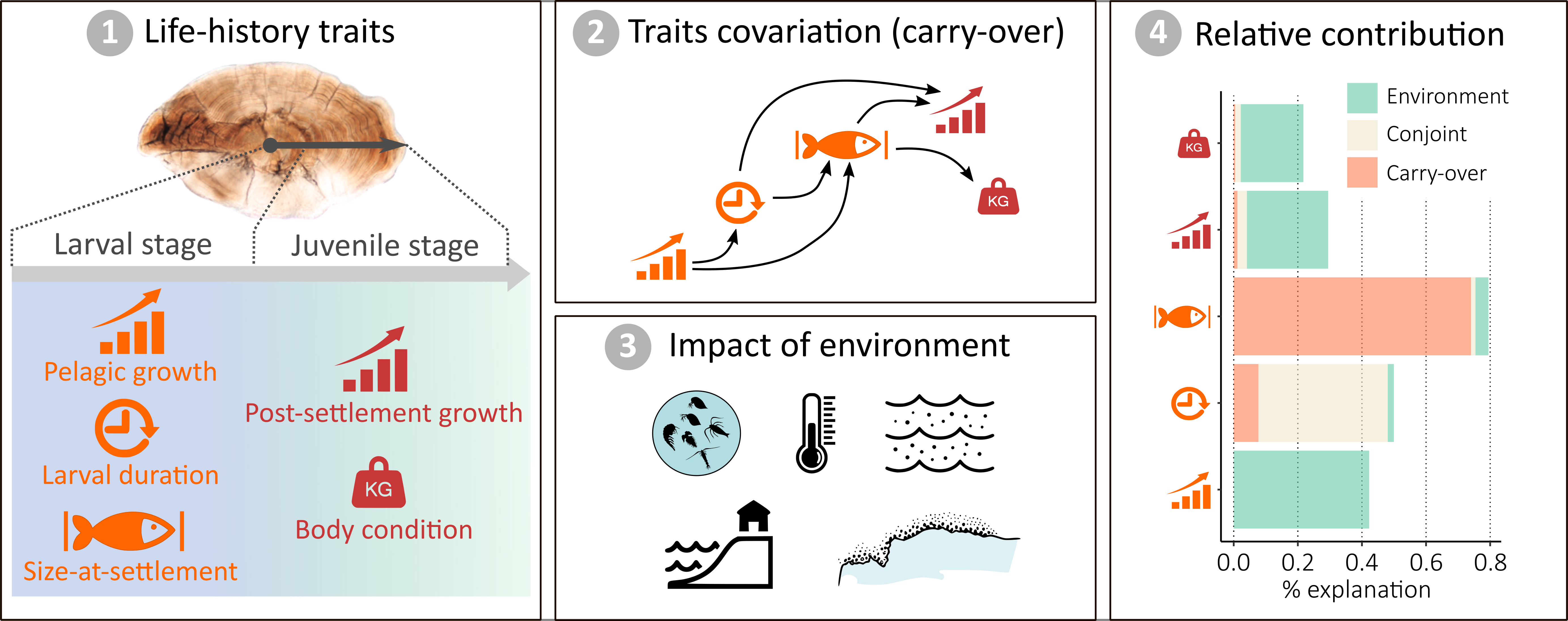Teichert, Nils, Anne Lizé, Henrique Cabral, Anthony Acou, Thomas Trancart, Laure-Sarah Virag, Eric Feunteun et Alexandre Carpentier. 2023. « Decoupling Carry-Over Effects From Environment In Fish Nursery Grounds ». Science Of The Total Environment 857: 159487. doi:10.1016/j.scitotenv.2022.159487.
Life-history trait expression not only depends on the current environmental constraints, but also on the past ones that shaped traits expressed earlier in life. To date, the impacts of environmental and human stressors on post-settlement traits have been assessed, but independently from larval traits, so that the contributions of environmental versus carry-over constraints remain unquantified. Here, we used a reconstructive approach based on otolith microstructure to investigate how carry-over and environment affect life-history traits of the European seabass, Dicentrarchus labrax. In the northeast Atlantic Ocean, seabass juveniles were collected in six French estuarine nursery areas with contrasted environmental conditions (water temperature, salinity, food availability, and anthropogenic impacts), and five of their life-history traits across ontogenetic stages were measured (pelagic growth, larval duration, size at settlement, post-settlement growth and body condition). Piecewise structural equation model emphasized the strong co-variation of larval traits in response to food availability and temperature in the pelagic environment, stressing that fast growing larvae are characterized by shorter pelagic larval duration, but larger size at recruitment. However, the magnitude of carry-over effects greatly varied between traits, revealing that larval trait impacts on post-settlement traits remained minor as compared to the nursery environment. In estuarine nurseries, our findings suggest that resource allocation results from a trade-off between somatic growth and energy storage. Fish juveniles exposed to anthropogenic stress or risk of food limitation tended to predominantly invest in storage, whereas individuals in favourable conditions allocated their resources in somatic growth. These findings highlight the importance of heterogeneity in pelagic and nursery environments in understanding trait variations and population dynamic of estuarine dependent fish.
BOREA contact: Nils Teichert, nils.teichert@mnhn.fr
Life-history trait expression not only depends on the current environmental constraints, but also on the past ones that shaped traits expressed earlier in life. To date, the impacts of environmental and human stressors on post-settlement traits have been assessed, but independently from larval traits, so that the contributions of environmental versus carry-over constraints remain unquantified. Here, we used a reconstructive approach based on otolith microstructure to investigate how carry-over and environment affect life-history traits of the European seabass, Dicentrarchus labrax. In the northeast Atlantic Ocean, seabass juveniles were collected in six French estuarine nursery areas with contrasted environmental conditions (water temperature, salinity, food availability, and anthropogenic impacts), and five of their life-history traits across ontogenetic stages were measured (pelagic growth, larval duration, size at settlement, post-settlement growth and body condition). Piecewise structural equation model emphasized the strong co-variation of larval traits in response to food availability and temperature in the pelagic environment, stressing that fast growing larvae are characterized by shorter pelagic larval duration, but larger size at recruitment. However, the magnitude of carry-over effects greatly varied between traits, revealing that larval trait impacts on post-settlement traits remained minor as compared to the nursery environment. In estuarine nurseries, our findings suggest that resource allocation results from a trade-off between somatic growth and energy storage. Fish juveniles exposed to anthropogenic stress or risk of food limitation tended to predominantly invest in storage, whereas individuals in favourable conditions allocated their resources in somatic growth. These findings highlight the importance of heterogeneity in pelagic and nursery environments in understanding trait variations and population dynamic of estuarine dependent fish.
BOREA contact: Nils Teichert, nils.teichert@mnhn.fr




